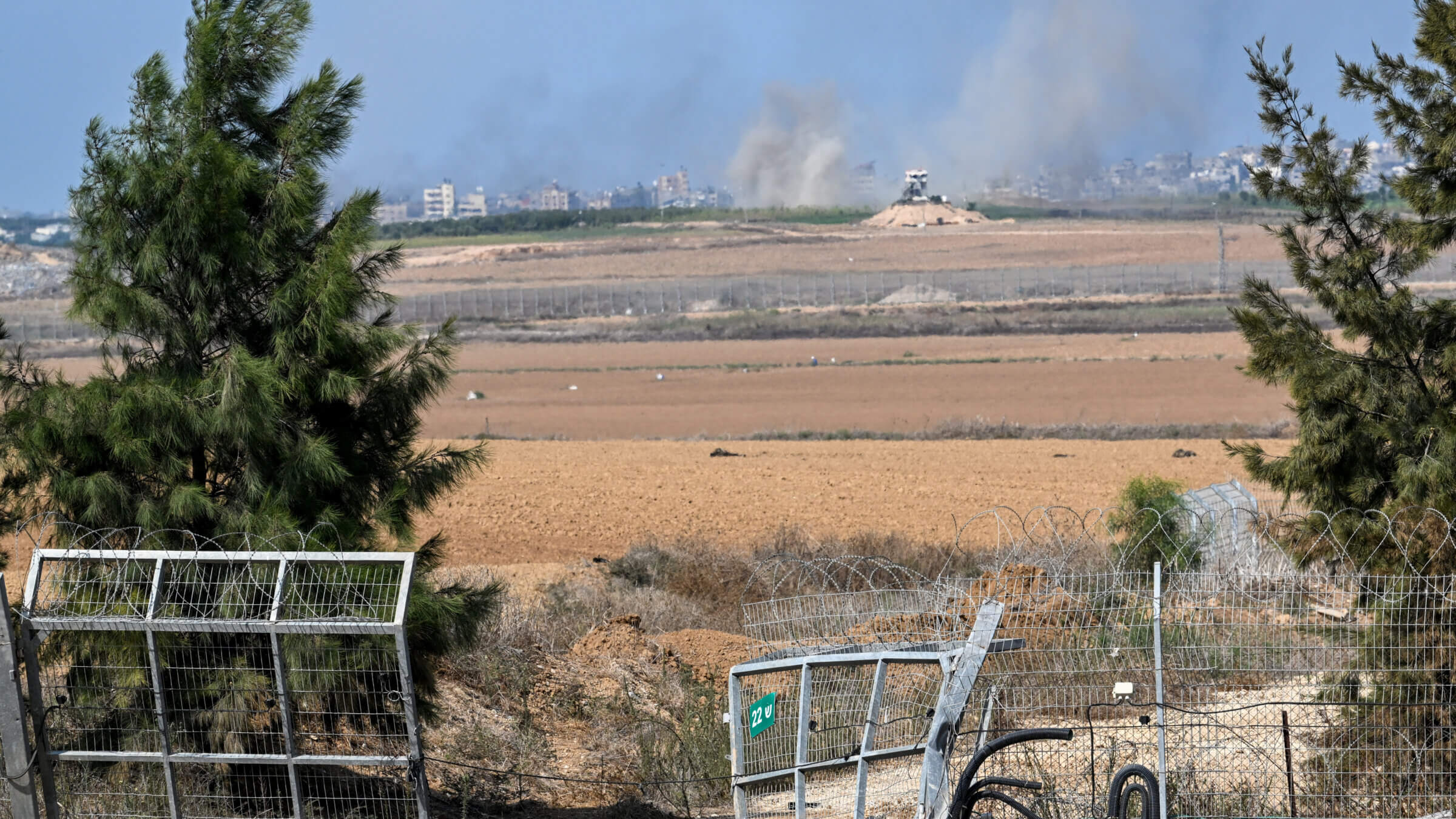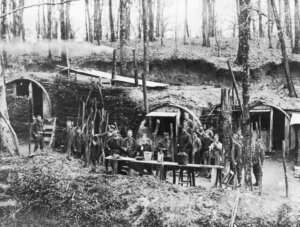As in 1940 France, Israel’s fortified border protected only a false sense of security
As Hamas terrorists crossed the divide, they recalled the time Germany breached the Maginot Line

Smoke rises in the distance from Gaza near the spot where Hamas militants broke through the fence near the Gaza border. Photo by Getty Images
“Something there is that doesn’t love a wall/ That wants it down.”
Robert Frost was neither a military strategist nor policy wonk, but his poem “Mending Wall” captures the paradox of defensive walls. While walls are often built to defend against others, those same others almost as often find ways to bring it down — or, lacking that, to go around, under, or above those walls.
This was the case last Saturday when more than 1,500 Hamas terrorists glided above, sailed around as well as blasted through the defensive fence dividing Gaza from Israel. By the time the Israeli military grasped the attack’s magnitude and mobilized its defense forces, the terrorists were rampaging across the border region. When the units of the Israel Defense Forces finally cohered and cleared the area, they discovered the bloodied and battered bodies of more than 1,200 people, including children.
Among the many terrible questions posed by these terrifying events is how the defensive fence was so easily breached. Upon its completion in 2021, the fence was described as “one of the most complex projects” ever undertaken by Israeli defense officials. Stretching more than 40 miles and costing more than $1 billion dollars, the barrier was a 20-foot-high hurdle of metal stanchions and barbed wire, bristling with an array of radars and cameras designed to sense the slightest of movements on the other side.
But the wall also had a subterranean component equipped with sensors meant to detect the drilling of tunnels. (In 2006, Hamas used tunnels to ambush an Israeli army unit, killing two soldiers and kidnapping a third, Gilad Shalit, who was released five years later in exchange for more than 1,000 Palestinian prisoners.) At the official unveiling of the fence, Brigadier General Eran Ofran acknowledged that nothing can be 100% secure, but he added that, “We are on guard all the time to watch and improve and ensure that the other side cannot pass.”
Yet the other side did pass. That they did would not have surprised anyone who lived through the fall of France in 1940, a military disaster as unexpected as the one that has just played out in Israel. Then, as now, a nation had built a defensive rampart against a hostile neighbor. Then, as now, the barrier’s existential raison d’être justified its extraordinary expense. And then, as now, the wall proved worse than useless, lulling those it ostensibly protected into a fall sense of security.
The wall in question is la ligne: the Maginot Line. This massive defensive network of forts and barriers France built in the 1930s along its eastern frontier with Germany has long since morphed into myth and memes. Yet the causes and consequences to the construction of the Maginot Line offer insight into what just occurred in Israel. The parallels are not just telling, but also tragic.

In contemporary black-and-white photos of the Maginot Line, the images of the walls and forts strike us as the work of a steampunk animator. As for color photos of the ruined and bare remains of today’s Maginot Line, it can be confused with a set design for a dystopian film. The fortifications, though built to withstand storms of shells, have failed to withstand the passage of time.
Yet when it was completed in 1935, the Maginot Line was, like the Gaza fence, marvelously modern. The 87 miles of pillboxes, casemates and forts, topped with disappearing turrets and connected by a network of tunnels along which ran electric trains, represented the last word in military architecture and technology. But it seemed well worth a price tag, more than 7 million francs, that nearly broke the French treasury. After all, the impenetrability to shelling of the forts’ 10-feet-deep concrete walls seemed to guarantee the impenetrability of France to German invasion.
This security guarantee was a political and strategic imperative. The planning for the Maginot Line in the 1920s was the consequence of what had happened in the Great War. Nearly 1.5 million French soldiers died between 1914 and 1918 — about 3.5% of total population of 40 million. This was both a moral and a demographic disaster. Just as population trends in Gaza and the West Bank are outstripping those in Israel, so too were Germans increasingly outnumbering the French.
For this reason, as the military historian Martin Alexander points out, security was more than a watchword for French policy makers after 1918. Instead, the notion became the new creed of “sécurité d’abord,” which roughly translates as, “It’s the security, stupid.”
The Maginot Line thus had two overriding goals. First, it sought to “sanctuarize” the nation against a real and present danger. The common phrase used by politicians and generals was “to assure the inviolability of the national territory.” Second, the line was meant to put concrete and steel between the bodies of French soldiers and the barrels of German guns.
The defensive wall along Gaza served the very same purposes. While the Second Intifada did not bleed Israel white to the extent that the First World War bled France, it was bloody enough. Between late September 2000 and early February 2005 — roughly the same duration as WWI — 138 suicide attacks occurred in Israel.
According to the Shin Bet security service, 1,038 people who had been going about their lives suddenly had those lives ended. (Crucially, the Israeli human rights organization B’Tselem reports that 3,189 Palestinians were killed by Israeli defense forces during that same period.)
Following the Seder Night Massacre at the Park Hotel in Netanya in 2002, the ever-widening spiral of violence led to the creation of a different kind of wall. The IDF launched Operation “Protective Wall,” but the results failed to fully wall off other terrorist attacks. The emotional consequences were deep and enduring. Though psychiatrists might argue over the clinical relevance of the term, trauma nevertheless seems the right word to describe Israeli society after the Intifada, one burdened by the pervasive fear and anxiety caused by the suicide bombings.
Inevitably, other walls were to follow. After Israeli forces unilaterally withdrew from Gaza in 2005, the unexpected rise to power of Hamas led to an all-too-expected rise in violence along the border with Israel. Hence the construction of the defensive fence that was meant to stem the incursions. The Army chief, Brigadier General Aviv Kochavi, declared that the barrier “is part of the iron wall of our policy on defense, on the ground, in the air, at sea and in general.” Its presence on the border, he predicted, “changes reality — what came before will be no longer.”
Kochavi was right, but perhaps for the wrong reasons. Reality did change in Israel during the past few years, as it did in France during the 1930s. As the French historian Alistair Horne concluded, the Maginot Line “came to be not just a component of strategy, but a way of life,” leading to fatal combination of complacency, conceit and confirmation bias.
When the time comes for scholars to assess the role played by the fence in the current war against Hamas, they may discover that that “most complex project” might well have changed reality in a similar fashion. There is always something or someone who doesn’t like a wall and wants it down, but the answer may not lie in building an even bigger wall.
















